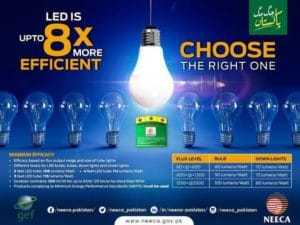In December 2020, new mandatory minimum energy performance standards (MEPS) for energy efficient LED lighting come into force in Pakistan, supported by a 5-star energy labelling scheme.
 This represents a key milestone in the Global Environment Facility-funded project, Delivering the Transition to Energy Efficient Lighting in Residential, Commercial, Industrial, and Outdoor Sectors, supported by the United Nations Environment Programme United for Efficiency (U4E) initiative, working closely with Pakistan’s National Energy Efficiency and Conservation Authority (NEECA). Multiple other local institutions form part of the project, including the Pakistan Standards and Quality Control Authority (PSQCA), which is the national standardization body, and the Pakistan Council for Scientific and Industrial Research (PCSIR) in its role of accredited organization in charge of electronic testing facilities, as well as local manufactures and their associations, universities and academic institutions and U4E technology partners.
This represents a key milestone in the Global Environment Facility-funded project, Delivering the Transition to Energy Efficient Lighting in Residential, Commercial, Industrial, and Outdoor Sectors, supported by the United Nations Environment Programme United for Efficiency (U4E) initiative, working closely with Pakistan’s National Energy Efficiency and Conservation Authority (NEECA). Multiple other local institutions form part of the project, including the Pakistan Standards and Quality Control Authority (PSQCA), which is the national standardization body, and the Pakistan Council for Scientific and Industrial Research (PCSIR) in its role of accredited organization in charge of electronic testing facilities, as well as local manufactures and their associations, universities and academic institutions and U4E technology partners.
The project objective is to secure significant global climate change mitigation and environmental benefits by instituting efficient lighting policies and creating a framework for innovative financial mechanisms that promote innovative and high efficiency products. According to the U4E Country Savings Assessment for lighting products in Pakistan, the market transformation to more energy efficient lighting technologies will enable electricity, GHG emissions and financial savings by 2030 of:
- 1 million tonnes of CO2 emissions from avoided burning of fossil fuels.
- 1.2 TWh on electricity savings.
- Over $ 120 million USD savings in electricity costs.
A first key step towards achieving this was the development of a national efficient lighting policy and strategy which contains the regulatory framework for MEPS and labelling. This was undertaken using a collaborative approach through in-person and virtual consultation workshops in Karachi and Islamabad during 2019 and 2020. More than 90 stakeholders from the public and private sector participated to agree on the technical criteria for the lighting MEPS policy. This included representatives from importers and manufacturers, and NEECA. The meetings focussed on capturing all points of view and reaching agreement on:
- The scope of the lighting sources to be included in the regulation.
- The criteria to be covered by the regulation and the performance levels.
- A proposal for a labelling scheme.
Underpinning these discussions were the results of a Lighting Market Assessment carried out by NEECA, which gathered data through a detailed local market survey, and the U4E Model Regulation Guidelines for General Service Lamps. The study showed that LED technologies already have major penetration in the Pakistani lighting market. Their market share reaches 55% for the domestic, tertiary and industrial sector, followed by tubular lamps (23%) and CFLs (21%). Against this background, the MEPS proposal aimed to enhance the best quality LED products, for a rapid phase-out of CFL lamps and incandescent bulbs. Minimum energy performance requirements were defined and agreed for LED bulbs, LED downlights, LED tubes and LED outdoor lighting.
The agreed MEPS exceed the efficacy level of 35% recommended in the U4E Model Regulation Guidelines for the domestic sector and include additional performance criteria. They also compare favourably with the European Lighting Standards. This reflects the high ambition of Pakistan to truly transform their market to best quality LED products and the commitment from the local stakeholders to remove obsolete and inefficient products from the market.
The project has also provided capacity building workshops for NEECA, and the wider public, to deliver technical training on the developed MEPS, along with information on sustainable public procurement best practices and technical recommendations to foster energy efficient lighting purchases in the public and semi-public sector.
To support the implementation of the MEPS, a 5-star label was proposed for the four categories: LED bulbs, tubes, down-lighters and street lighting/outdoor lighting. Having one label scheme, with one set of fixed values applicable to all LED products, simplifies its implementation by manufacturers, while also reducing the work for local authorities in charge of market surveillance. This labelling scheme will also require manufacturers to affix a NEECA-provided security sticker to LED lighting products that carry the 5-star Energy Label. Each sticker has a unique security code, revealed by scratching off the surface of the sticker, which can be used by the purchaser to obtain an instant digital verification that the product is compliant with regulations.
Throughout the project, the Government of Pakistan has been committed to spreading the message to its citizens on the benefits of LED lighting and energy efficient labels, using communication campaigns to encourage broad public acceptance and help modify user behaviour. A wide range of communication and outreach activities have taken place, including lectures by U4E technical experts and NEECA energy officers at academic institutions, radio and television broadcasts, and digital campaigns on social media with videos and informative brochures. These resources provide useful information on the benefits of the switch to LED lighting, tips and recommendations for a more conscious use of lighting products and energy conservation, and the date of enforcement for the upcoming MEPS regulation with the corresponding levels.
For more information on the project and U4E’s work in Pakistan, contact Paul Kellett at paul.kellett@un.org.


Leave a Reply